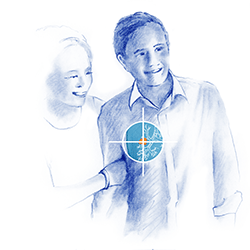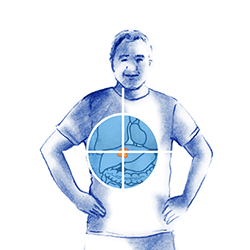Which is your type of cancer?
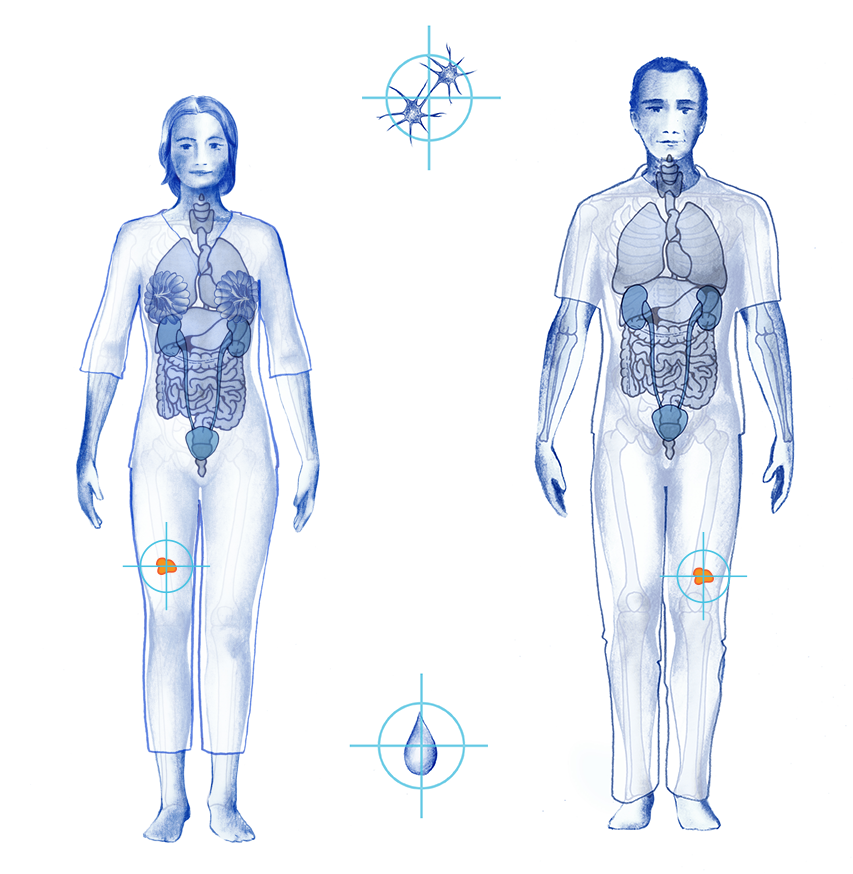
Central nervous system tumours
- Non-invasive treatment, no general anaesthetic or incision
- Treatment of inoperable tumours (reaches areas where surgery cannot)
- Improvement in disease control
- Fewer and more effective sessions
- Improved preservation of cognitive function
- Limits radiation in healthy brain tissue
- Adapts to the tumour
- Safer re-irradiation possible
Central nervous system tumours
- Non-invasive treatment, no general anaesthetic or incision
- Treatment of inoperable tumours (reaches areas where surgery cannot)
- Improvement in disease control
- Fewer and more effective sessions
- Improved preservation of cognitive function
- Limits radiation in healthy brain tissue
- Adapts to the tumour
- Safer re-irradiation possible
Tumours of the head and neck
- Alternative to surgery, no marks or scars.
- Preservation of function: voice preservation.
- Improvement in disease control.
- Symptom control in advanced disease.
- More effective treatment in a shorter time.
- Treatment zone adjustment.
- Adapts to the tumour and the patient.
- Safer re-irradiation.
Tumours of the head and neck
- Alternative to surgery, no marks or scars.
- Preservation of function: voice preservation.
- Improvement in disease control.
- Symptom control in advanced disease.
- More effective treatment in a shorter time.
- Treatment zone adjustment.
- Adapts to the tumour and the patient.
- Safer re-irradiation.
Lung Cancer
- Curative treatment, non-invasive alternative to surgery.
- Ideal treatment for inoperable tumours.
- Helps control pain or breathing difficulty.
- Less radiation to healthy tissue, helps to maintain respiratory capacity.
- It breathes with you, in synchronisation with respiratory movement, during the session.
- Reduced side effects.
- Fewer days (sessions) of treatment.
- Greater comfort during the session.
Lung Cancer
- Curative treatment, non-invasive alternative to surgery.
- Ideal treatment for inoperable tumours.
- Helps control pain or breathing difficulty.
- Less radiation to healthy tissue, helps to maintain respiratory capacity.
- It breathes with you, in synchronisation with respiratory movement, during the session.
- Reduced side effects.
- Fewer days (sessions) of treatment.
- Greater comfort during the session.
Breast cancer
- Indicated in the majority of cases.
- Non-invasive treatment, no anaesthetic.
- Reduces the risk of recurrence after conservative surgery.
- Helps to control symptoms.
- Delivery of a more uniform, homogeneous dose.
- Higher precision.
- Fewer side effects.
- Adapts to the tumour.
Hepatobiliary and pancreatic tumours
- Non-invasive curative treatment.
- Alternative in tumours where other treatments have been ruled out.
- Enables surgery, in some cases.
- Improves pain caused by the tumour.
- Synchronisation with tumour motion.
- Reduction in side effects.
- Shorter treatments.
- Safer re-irradiation in recurrent disease.
Hepatobiliary and pancreatic tumours
- Non-invasive curative treatment.
- Alternative in tumours where other treatments have been ruled out.
- Enables surgery, in some cases.
- Improves pain caused by the tumour.
- Synchronisation with tumour motion.
- Reduction in side effects.
- Shorter treatments.
- Safer re-irradiation in recurrent disease.
Gastrointestinal tumours:
- Tratamiento de elección en tumores anales.
- En tumores de recto aumenta la posibilidad de cirugía con conservación de esfínter anal (evitar bolsa colostomía).
- En estadios avanzados es fundamental para el control de la enfermedad.
- Ayuda a controlar los síntomas (sangrado o dolor).
- Reduce los efectos secundarios.
- Se adapta a los cambios del tumor.
Gastrointestinal tumours:
- Treatment of choice in anal tumours.
- Improvement in likelihood of sphincter-preserving surgery (to prevent the need for colostomy) in rectal tumours.
- In advanced stages it is fundamental for disease control.
- Reduction in side effects.
- Adapts to changes in the tumour.
Prostate cancer
-
- Reduced side effects.
- Fewer, more effective sessions.
- More comfortable for the patient.
- Curative treatment, non-invasive alternative to surgery.
- Improved preservation of sexual function.
- Improved maintenance of urinary continence.
- Safe rescue treatment after surgery.
- Synchronisation with tumour motion. Safer and more precise.
- It affects a smaller area of the bladder.
- Reduced side effects.
- Fewer, more effective sessions.
- More comfortable for the patient.
Genitourinary tumours
- Non-invasive, pain-free treatment, alternative to surgery.
- Helps to control the disease.
- Bladder preservation (avoids a stoma bag).
- Helps to control symptoms such as pain or bleeding when passing urine.
- Higher precision and safety.
- The bladder volume (amount of urine) and rectal volume (faecal or gas content) have less effect.
- Shorter (fewer sessions) and effective treatments.
- More comfortable for the patient.
Genitourinary tumours
- Non-invasive, pain-free treatment, alternative to surgery.
- Helps to control the disease.
- Bladder preservation (avoids a stoma bag).
- Helps to control symptoms such as pain or bleeding when passing urine.
- Higher precision and safety.
- The bladder volume (amount of urine) and rectal volume (faecal or gas content) have less effect.
- Shorter (fewer sessions) and effective treatments.
- More comfortable for the patient.
Gynaecological Tumours
- Treatment of choice for inoperable advanced tumours.
- Reduced risk of locoregional recurrence after surgery.
- Symptom control (bleeding or pain).
- Safer and more precise.
- The bladder volume (amount of urine) and rectal volume (faecal or gas content) have less effect.
- Fewer side effects. .
- More comfortable for the patient,
- Safer re-irradiation.
Haematological tumours
- Good and rapid response to treatment.
- Enables treatment of different areas at the same time, including total body irradiation (TBI).
- Improvement in symptom control (bone pain with or without soft tissue mass).
- Adapts to changes in tumour volume and the patient's anatomy.
- Fewer side effects.
- More comfortable for the patient.
Metastasis
- Good and rapid response to treatment.
- Enables treatment of different areas at the same time, including total body irradiation (TBI).
- Improvement in symptom control (bone pain with or without soft tissue mass).
- Adapts to changes in tumour volume and the patient's anatomy.
- Fewer side effects.
- More comfortable for the patient.
Sarcomas
- Non-invasive, pain-free treatment.
- Improvement in local disease control and survival.
- Facilitates surgery.
- Prevention of traumatic surgery (amputation).
- Well tolerated, allows normal daily life during treatment.
- Adapts to changes in the tumour and/or the patient.
Sarcomas
- Non-invasive, pain-free treatment.
- Improvement in local disease control and survival.
- Facilitates surgery.
- Prevention of traumatic surgery (amputation).
- Well tolerated, allows normal daily life during treatment.
- Adapts to changes in the tumour and/or the patient.
central nervous system tumours

These tumours may affect motor function (walking, talking) as well as sensory function, due to the central nervous system being the human body’s control centre.
Many are situated close to critical structures (speech centre, brain stem – where the nerves exit – etc.), making it impossible to perform surgery completely.
All this negatively impacts the patient’s quality of life and their emotional state.
Radiotherapy, as a non-invasive treatment, enables safer treatment of certain critical areas of the brain (brain stem, spinal cord, etc.), where precision is particularly important.
Key points:
- Effective alternative to surgery: non-invasive treatment (no incision or general anaesthetic).
- Complementary to surgery when it isn’t feasible to achieve a gross total resection.
- Normal daily life during treatment in the majority of cases.
Advantages of radiotherapy at HC:
- Fewer, more effective sessions (stereotactic radiosurgery or SRS).
- Better preservation of cognitive function, short-term memory and concentration.
- High precision, limiting radiation doses in healthy brain tissue.
- Adapts to morphological changes of the tumour in realtion to edema and/or shape changes.
- Makes re-irradiation possible, enables safer treatment to the patient.
tumours of the head and neck
Tumours of the oral cavity, pharynx and larynx affect the ability to speak and eat and can often cause pain.
Surgical treatment is often targeted at achieving eradication of the tumour, however, often this entails loss of function (hoarseness) or significant aesthetic changes (deformities, large incisions in the face/neck).
Radiotherapy, as a non-invasive treatment, enables the preservation of function in different areas, e.g. the voice in laryngeal cancer.
Key points in radiotherapy treatment:
- Effective alternative to surgery: non-invasive treatment (no incision or general anaesthetic).
- Complementary to surgery when complete resection is not possible.
- Function preservation (voice preservation).
- Generally, normal daily life during treatment.
Why this type of radiotherapy?
- More effective treatment in a shorter time.
- Limits the treatment zone as much as possible.
- Adapts to tumour volume changes and to changes in the patient (frequently weight loss).
- Makes re-irradiation possible with greater safety for the patient.
lung cancer
Lung cancer is one of the most common cancers and has a higher mortality rate. In the early stages it often presents no symptoms, therefore the disease is often detected when it has already advanced. Symptoms commonly developed are chest pain, shortness of breath, hoarse voice and persistent cough
Radiotherapy is a non-invasive treatment, which is safely performed in patients when surgery is not possible, achieving tumour control.
It enables shorter, effective treatments such as stereotactic body radiotherapy, or SBRT, in early cases, preventing surgery.
In patients with more advanced disease, it complements surgery achieving improved disease control.
It helps control symptoms (pain or breathing difficulty) and improves the patient’s quality of life.
Key points of radiotherapy treatment:>/span>
- Effective alternative to surgery: non-invasive treatment (no incision or general anaesthetic).
- Complementary to surgery when surgery cannot completely remove the tumour.
- Treatmentof choice for inoperable patients.
- Generally, normal daily life during treatment.
Why this type of radiotherapy?
- Synchronisation with tumour motion, enhancing precision.
- Reduction in side effects, especially to healthy lung and heart.
- Fewer days (sessions) of treatment.
- Greater comfort during sessions, due to not requiring respiratory restrictive techniques or uncomfortable immobilisation systems.
- Adapts to the tumour which can become inflamed and change shape.
- Possibility of safer re-irradiation.
breast cancer
Breast cancer is often diagnosed incidentally during screening mammography or other imaging tests. However, sometimes patients have pain or a pricking sensation in the affected breast.
Primary treatment is surgery. Radical mastectomy achieves better disease control in comparison with conservative surgery alone. Post-operative radiotherapy enables conservative treatment to be performed with the same disease control as mastectomy. Thus, the patient avoids more complicated surgery and the emotional impact of losing the affected breast, as well as possible complications from prosthesis implant.
In more advanced tumours, when mastectomy is required, radiotherapy may be necessary to ensure that not a single tumour cell remains, whilst helping to palliate symptoms such as ulcerated or bleeding lesions.
Key points of radiotherapy treatment:
- Non-invasive and pain free.
- Complementary to elective conservative treatment.
- Improved disease control, following mastectomy, in some cases.
- Generally, normal daily life during treatment.
- Good cosmetic result.
Why this type of radiotherapy?
- Delivery of a more uniform, homogeneous dose.
- Higher precision.
- Fewer side effects, especially in the healthy lung on the same side and the heart (especially important in cancer of the left breast).
- Adapts to changes in tumour morphology (it may become inflamed and change shape).
hepatobiliary and pancreatic tumours
Pancreatic tumours often cause abdominal or back pain, loss of appetite or significant weight loss, making the patient very weak.
As symptoms are nonspecific and there is sometimes a delay in their appearance, a high percentage of patients are diagnosed when the disease is already advanced and therefore not suitable for surgery.
Radiotherapy achieves improved tumour control when the tumour is inoperable.
In borderline tumours, it can enable the patient to become a candidate for surgery.
It improves pain caused by this type of tumour.
Key points of radiotherapy treatment:
- Non-invasive, pain-free treatment.
- Alternative for tumours not suitable for surgery.
- In some cases, it makes surgery possible.
- Improvement in symptoms caused by the tumour.
- Generally, normal daily life during treatment.
- Reduction in side effects.
- Adjustment to the morphological changes changes in the tumour (which can become inflamed and/or change shape).
- Shorter treatment (SBRT).
- Enables safe re-irradiation in recurrence.
gastrointestinal tumours
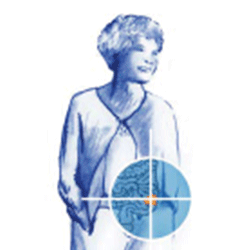
Oesophageal or gastric tumours can make it impossible or difficult to eat, they can cause pain, loss of appetite, nausea and vomiting, all of which lead to the patient feeling weak.
Rectal and anal tumours can cause constipation, bowel obstruction or even faecal incontinence. They also cause blood in the stools and abdominal or regional pain.
As a result, the patient can feel constantly uncomfortable having a severe, negative impact on the patient’s quality of life.
Ideally these tumours are treated surgically to achieve complete removal. However, sometimes it is impossible to remove it entirely, and on many occasions, removal involves dependence on a stoma bag (colostomy) permanently.
Radiotherapy is a fundamental part of the multidisciplinary treatment in this type of tumour. It not only improves symptoms, but also disease control. Prior to surgery, it can reduce, or even eliminate the tumour, facilitating surgery and on occasion preventing the need to depend on a stoma bag forever.
Key points of radiotherapy treatment:
- Non-invasive, pain-free treatment.
- An alternative in tumours not suitable for surgery.
- Function preservation. (no colostomy bag).
- Fundamental in some cases to increase disease control following surgery.
- Generally, normal daily life during treatment.
Why this type of radiotherapy?
- Delivery of a more uniform, homogeneous dose.
- It reduces side effects.
- It adapts to the morphological changes in the tumour (it can become inflamed and/or change shape).
- Makes re-irradiation possible more safely.
prostate cancer
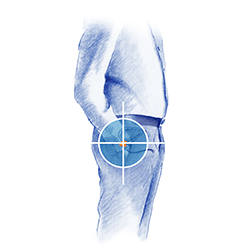
Prostate tumours cause a series of uncomfortable symptoms for the patient which range from discomfort during urination, to incontinence or sexual dysfunction.
Other treatments control the disease, but with a greater impact on sexual or urinary function.
Radiotherapy, however, is a very effective treatment which controls prostate cancer with a minimal impact on sexual and urinary function.
Key points of radiotherapy treatment:span>
- Non-invasive, pain-free no invasivo e indoloro treatment.
- Good disease control..
- Minimal impact on sexual function (dysfunction) and urinary tract (incontinence).
- Normal daily life during treatment, the majority of the time.
Why this type of radiotherapy?
- Synchronisation with movement of the tumour increasing safety and precision.
- Due to the ability to adapt to the patient’s anatomy, the bladder volume (amount of urine) and rectal volume (faecal or gas content) have less effect.
- Fewer side effects.
- Shorter, effective treatments (fewer sessions).
- More comfortable for the patient.
- Safer re-irradiation for the patient.
genitourinary tumours
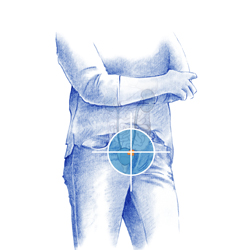
Genitourinary tumours cause a series of uncomfortable symptoms for the patient which may include burning with urination or even incontinence or abnormal sexual function.
Other treatments control the disease, but at the cost of leaving the patient with more severe sexual dysfunction or with a higher chance of requiring a stoma bag for life, due to removal of the bladder.
However, radiotherapy treatment controls the disease, limiting its impact on sexual and urinary function.
Key points of radiotherapy treatment:
- Non-invasive, pain-free. treatment.
- Less effect on sexual function..
- Enables bladder preservation (avoiding a permanent stoma bag).
- Generally, normal daily life during treatment.
Why this type of radiotherapy?
- Safer and more precise.
- Capacity to adapt to the patient’s anatomy, the bladder volume (amount of urine) and rectal volume (faecal or gas content) have less effect.
- Shorter, (fewer sessions) effective treatment.
- More comfortable. for the patient
gynaecological tumours

Gynaecological tumours (endometrium, cervix, vagina) cause uncomfortable symptoms such as menstrual-type bleeding, abdominal pain and discomfort on passing urine.
Radiotherapy offers an effective treatment in this type of tumour, both alone and together with other treatments, such as surgery and/or chemotherapy.
Sometimes, when the tumour is already more advanced, radiotherapy can help to control symptoms (generally those related to bleeding) and thus improve the patient’s quality of life.
Key points of radiotherapy treatment:
- Non-invasive, pain-free treatment.
- Good disease control..
- Treatment of choice for inoperable tumours.
- Generally, normal daily life during treatment.
Why this type of radiotherapy?
- Safer and more precise.
- Capacity to adapt the patient’s anatomy, the bladder volume (amount of urine) and rectal volume (faecal or gas content) have less effect. .
- Fewer side effects.
- More comfortable for the patient.
- Safer re-irradiation for the patient.
haematological tumours

Haematological tumours are a complex group of blood and lymphatic system tumours that can develop in different parts of the body.
They often appears in the form of a conglomerate lymph node mass causing pain or lymphoedema (limb swelling). In the case of multiple myeloma, the tumour has a predilection for bone which then causes pain in the different parts of the skeleton affected.
These tumours are generally very sensitive to chemotherapy and radiotherapy, the treatment of choice is therefore a combination of both.
Radiotherapy is a non-invasive and well tolerated treatment which helps chemotherapy to achieve optimal curative rates and in some cases improve pain caused by the disease.
Key points of radiotherapy treatment:span>
- Tumours are generally very sensitive to radiation, with good results
- Non-invasive, pain-free. treatment.
- It increases disease control.
- Well tolerated, allowing normal daily life during treatment.
- It adapts to changes in tumour volume, as the tumour is very sensitive, its shape can alter during treatment.
- It adapts to changes in the patient’s anatomy (weight loss or weight gain due to the disease itself, or due to medical treatments).
- Fewer side effects.
- More comfortable for the patient..
- It enables treatment of different areas at the same time.
metastasis

When the tumour advances and spreads through the blood, systemic treatment (chemotherapy, immunotherapy or targeted therapy) is key to disease control.
However, sometimes local treatment, to improve control or improve symptoms, is required.
In these cases, radiotherapy is a short, non-invasive treatment which is generally well tolerated.
This treatment is important for central nervous system lesions, as some drugs struggle to reach this location; it is also important in bone, as bone tumours can be very painful and lead to loss of function.
There are some cases in which the number and size of metastases are limited, with radiotherapy treatment being able to control metastatic disease.
Puntos clave de la radioterapia:
- Non-invasive, pain-free treatment.
- Supportive treatment to control symptoms and improves quality of life.
- In selected cases, disease elimination, even if already disseminated.
- Well tolerated, allows normal daily life during treatment.
Why this type of radiotherapy?
- Synchronisation with tumour motion, increasing precision and safety, fundamental for lung or liver metastases.
- Fewer, more effective sessions (stereotactic body radiotherapy – SBRT or radiosurgery – SRS).
- Adjustment to changes in the tumour volume.
- Adjustment to changes in the patient’s anatomy.
- Fewer side effects.
- More comfortable for the patient.
sarcomas
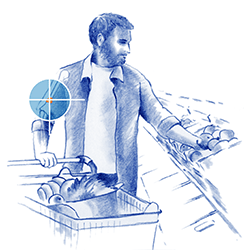
Soft tissue sarcomas can originate in fatty, muscle, fibrous, nerve, or even blood vessel tissue.
They generally present as masses or lumps in the limbs (arms or legs) although they can also appear in other areas.
Radiotherapy is an effective treatment that helps to control disease, reducing the tumour prior to surgery to make surgery easier, eliminating microscopic disease after surgery or visible disease after incomplete surgery.
If surgery is not possible, it may be considered as a principle treatment together with chemotherapy.
Key points of radiotherapy treatment:
- Non-invasive, pain-free treatment.
- Improved local disease control.
- Facilitates surgery.
- Well tolerated, it enables normal daily life during treatment.
Why this type of radiotherapy?
- Safer and more precise.
- Adapts to changes in tumour volume (these are tumours which initially inflame during treatment, increasing in size).
- Adapts to changes in the patient’s anatomy (weight loss or gain).
Before your appointment
The oncology team will study your case recommending you to the specialist in your tumor. Lorena, our oncology coordinator, will call you to make an appointment. When you come to your first appointment, the oncologist will already know your medical history.
recent reports,
pathology report,
last blood test,
last imaging test.
Would you like more information?
We can contact you, or if you prefer, call us on 952 908 898


